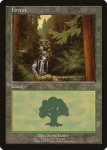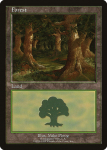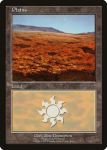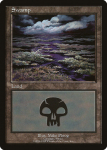Back in 1998, Wizards of the Coast released a special set of basic land cards specifically for the European market.
Back in 1998, a special land card promotion in Asia featuring lands based on specific Asian locations was implemented successfully. Due in part to the promotional cards, Magic: The Gathering gained more traction in Asia (not to mention that the special land cards proved pretty popular elsewhere).
At the same time, Wizards of the Coast was looking for a boost in the European market. While the collectible card game was popular, as seen by a large number of professional players, a lot of countries still didn't have that large of a playing community. Could the same formula work in Europe as it had in Asia?
So, just two years after the APAC cards, WotC's Magic folks went off to Europe for inspiration with a focus on western and central European countries. Italy's somma-stratovolcano, Mount Vesuvius, came to life within Magic as a basic mountain, as did the Alps' Mont Blanc and the Pyranese range that straddles the French-Spain border and is home to the small nation of Andorra. The Italian city of Venice became a basic island, as did a portion of Denmark and England's White Cliffs of Dover.
On the topic of England, Robin Hood's old crib, Nottingham Forest, was reimagined as one of MTG's basic forests, as did Germany's Schwarzwald (also known as the Black Forest) and Northern France's Brocéliande. The Euro swamps consist of Ardennes Fagnes, which is on the Germany-Beligum border, Southern France's Camargue, and Northwest England's Lake District National Park. For basic plains, Magic players were given the Scottish Highlands, Steppe Tundra (also known as Mammoth Steppe), which is an ecological region that spans from Spain through Eurasia and into Canada, and the lowlands of Netherlands, complete with one of the country's iconic windmills.
It almost seemed like every country, or at least nearly every region of central and western Europe received at least one representative card.
Just like the Asian promotion two years ago, the cards came out in color-coded, shrink-wrapped packs: blue, red, and purple. Every new expansion in 2000, Nemesis, Prophecy, and Invasion gave fans a chance to get them (so long as they lived in Europe). All they had to do was cut out the bar code from every booster box, mail it in, and bam: you suddenly had more scenic views of Europe than could be found in Rick Steves' scrapbook.
And, just like the previous Asian promotion, it proved pretty popular. The cards went fast, showing that Magic's popularity in Europe wasn't waning as feared. As it turns out, when something popular from another country gives your own region a shout out, people tend to like it a lot more.
Today, the cards are actually quite valuable thanks to their limited run. Some individual cards can come close to $100 each, with an entire set going for well over $500. The rarity of some of them, as well as the artists and just plain how cool some of them work factors in big time to the price as well. They even were obtainable recently on Magic: The Gathering - Arena as a limited-time promotion.
After the successful special land introductions to both Asia and Europe, another follow-up would be hard. While scenic, North America was pretty well saturated, and South America and Africa hadn't really been developed just yet. So, wanting to have yet another set come out of promotional lands, Magic decided to forgo geography and try something a bit more radical.
Wizards of the Coast had one word for it: Guru.
























